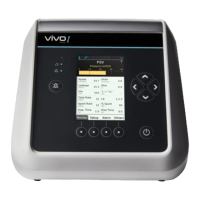
Do you have a question about the Breas Medical Vivo 1 and is the answer not in the manual?
| Type | Ventilator |
|---|---|
| Category | Medical Equipment |
| Modes | CPAP |
| Weight | 2.5 kg (including battery) |
| Battery Life | Up to 10 hours |
| Alarms | Apnea |
| Oxygen Compatibility | Up to 100% oxygen |
Provides contact details and address for Breas Medical AB, the manufacturer.
Describes the Vivo 1 as a non-invasive pressure ventilator for respiratory support.
Specifies the target patient weight and conditions for which the Vivo 1 is intended.
Defines qualified users like health care specialists, lay operators, and service personnel.
Lists medical conditions where the Vivo 1 is not recommended or contraindicated.
Explains the purpose of the manual and the use of icons within it.
Covers general safety risks including personal injury and faulty treatment.
Details electrical safety, including risks of electric shock and proper power supply usage.
Addresses safety related to the operating environment, toxic substances, and fire risks.
Outlines safety concerns regarding patient circuits, leaks, and mask usage.
Focuses on safe and effective use of air inlet filters and their impact on performance.
Covers safety aspects of using humidifiers and heated circuits, including suffocation risks.
Highlights safety procedures for cleaning and maintaining the device to prevent injury.
Provides safety guidelines for using the Vivo 1 with supplemental oxygen, addressing fire risks.
Details safety considerations when using the Vivo 1 during mobile or transit operations.
Identifies and describes the main parts and accessories of the Vivo 1 system.
Details the controls and indicators located on the front panel of the Vivo 1.
Describes the ports and connections found on the rear of the Vivo 1 ventilator.
Explains how the Vivo 1 manages power sources, including mains and external DC options.
Outlines the structure of the Vivo 1's menu system and how to navigate it.
Explains the various symbols found on the device's product information label.
Illustrates and describes the meaning of icons and indicators displayed on the Vivo 1 screen.
Describes the different ventilation modes available on the Vivo 1, such as PSV, S, S/T, and CPAP.
Details the configurable settings that affect the ventilating function of the Vivo 1.
Lists essential checks to perform before operating the Vivo 1 for the first time.
Provides guidelines on the correct and safe placement of the Vivo 1 unit.
Explains the procedure for connecting the Vivo 1 to both AC and DC power sources.
Guides users on how to properly connect the patient circuit to the Vivo 1.
Describes the process of powering up the Vivo 1 and performing initial function checks.
Instructs on how to turn on the Vivo 1 and put it into standby mode.
Details the procedure for initiating a treatment session and the associated self-test.
Explains how to safely stop an ongoing treatment session.
Guides on how to properly power down the Vivo 1 unit.
Describes how to access and interpret treatment data displayed on the monitor page.
Provides instructions on how to use various accessories compatible with the Vivo 1.
Offers solutions for common problems encountered during Vivo 1 operation.
Emphasizes the importance of operator position for effective alarm detection.
Explains how to identify, pause, reset, and manage various alarm conditions.
Details physiological alarms, their causes, and reset criteria.
Lists and explains technical alarms, including sensor failures and power issues.
Provides detailed instructions for cleaning the main unit and its components.
Guides on cleaning and replacing the air inlet filters for optimal performance.
Lists the physical dimensions and weight of the Vivo 1 ventilator.
Specifies the electrical requirements and characteristics of the power supply units.
Outlines the recommended operating and storage temperature, humidity, and pressure ranges.
Illustrates the airflow paths through the Vivo 1 with and without the bypass unit.
Presents technical data related to noise levels and performance characteristics.
Lists and describes disposable patient circuits and related consumables.
Details other accessories such as power supplies, cables, and protective covers.
Provides a template for recording patient-specific treatment settings.
Confirms the ventilator's compliance with FAA regulations for air travel.